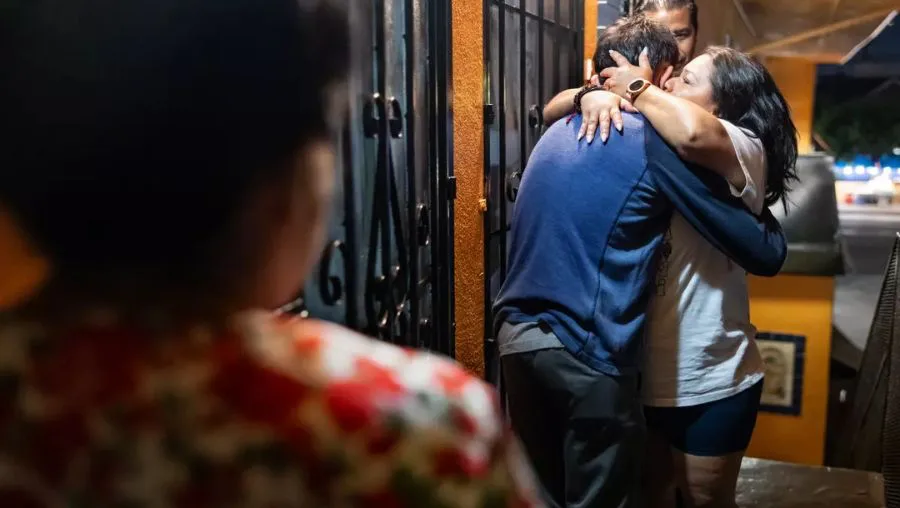On the early morning of June 12, 2025, Javier Diaz Santana went to work unsuspectingly. The 32-year-old was on his way to wash a car when he saw colleagues suddenly scattering in panic. A woman gestured frantically for him to flee. He didn’t understand why. He couldn’t hear the shouting - because Javier is deaf and mute. Seconds later, limping and with a painful foot, he climbed over a wall behind the car wash in the San Gabriel Valley. He made it just one block before two white SUVs blocked his path. Men wearing vests labeled “HSI” - Homeland Security Investigations - stepped out, armed and masked. They yelled. Javier couldn’t hear them. He raised his hands and pointed at his ears. It didn’t help. They took his wallet, then his phone. Finally, they put handcuffs on him, so tight they left marks. Communication was no longer possible. Javier is a DACA recipient. He came to the United States from Mexico at the age of five, has a valid work permit, no criminal record, speaks American Sign Language, and was legally on his way to work that morning. But ICE didn’t care. What followed was an almost month-long odyssey through the heart of an administration that didn’t just fail to accommodate disability - but simply disregarded the law. Diaz was shoved into an SUV and taken away - with no explanation, no interpreter, no chance to express himself. Later, on the agent’s phone, the question blinked: “What country are you from?” Javier couldn’t answer. His hands were cuffed.


What he didn’t know: he had been caught in a large-scale deportation program - part of an ICE offensive under President Trump that targeted DACA recipients, (DACA - “Deferred Action for Childhood Arrivals” - is a protection program introduced by President Obama for young migrants who came to the US as children. It grants them, under certain conditions, a work permit and protection from deportation), as well as people with valid residency permits. On June 15 - his first time on a plane - Diaz was flown to Texas in handcuffs. He was placed in solitary confinement at a detention center in El Paso. He was allowed to use pen and paper to write “bathroom.” Days passed in isolation. No subtitles on TV. No communication. No contact with his family, who were desperately trying to locate him. When his attorney Roxana Muro contacted the ICE facility, she initially received no response. Only when she sent an email with the subject “DEAF MUTE CLIENT DETAINED WITH DACA” did anyone react - but by then, Diaz was already en route to El Paso. His story is not an isolated case. Diaz is one of many migrants with legal protection status who have been swept up in the current deportation campaign in the US. And he is especially vulnerable - not just because he is deaf, but because the system left him no room to resist. At his hearing on July 2, he was provided a sign language interpreter for the first time in weeks. The judge was surprised: the case had been administratively closed, Diaz had no criminal history, posed no security threat. The DHS attorney even confirmed: yes, he has DACA. So why had he been arrested in the first place? His attorney answered: “Because they don’t care. They profile. If you look Mexican, they take you.” Diaz had been at work, entirely legally, when ICE struck. The judge set bail at the legal minimum of $1,500. Muro paid. On July 8, his mother’s birthday, Javier was released. But not without an electronic ankle monitor - and a set of instructions in Spanish, which he couldn’t read.
His return to Los Angeles was an 11-hour car trip through Arizona and New Mexico. His brother Miguel and a cousin picked him up - flying wasn’t an option without ID. Diaz was changed. Quiet. Reserved. He asked whether he was allowed to use the restroom. Whether he was allowed to eat. The experience had left marks. He wore the black ankle monitor like a stigma. When he finally reached the apartment building in South L.A. where his parents were waiting, it was night. Neighbors had made a poster: “Welcome Home, Javier” - also in sign language. His father rushed down the stairs. His mother waited in the hallway. Diaz looked absent, his arms heavy. When he hugged his mother, tears ran down her cheeks. His nearly too. Javier Diaz Santana is home again. But his case remains a warning - of an administration that refuses to see who is a person and who is merely a problem. Of a state that bends the law when it suits politics. And of a society that must not remain silent when silence becomes policy. That Diaz is back with his family today is no gift from the system - it is the result of a fight. A fight against silence, against violence, against an institutional muteness louder than any words. A happy ending - but one that still tastes bitter.
Investigative journalism requires courage, conviction – and your support.





Esist unglaublich mit welcher Brutalität vorgegangen wird.
Es war innerhalb kürzester Zeit kein „illegale Kriminelle“ abschieben.
Es wurde zu „Illegale“ ohne kriminelle Akte, hinüber zu „uns doch egal ob Du eine legale Aufenthaltserlaubnis hast“ um letztlich bei „ist doch egal, dass Du US Bürger bist“ zu enden.
Ob eswirklich damit endet? Der nächste Schritt ist politische Gegner und unliebsame Personen zu deportieren.
Wir kennen das. Deutschland 1933
Und wie damals, schaut die Welt weg.
Danke, dass Ihr diesen Menschen eine Stimme gebt